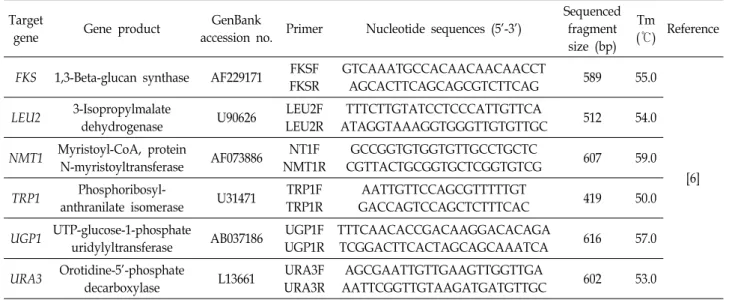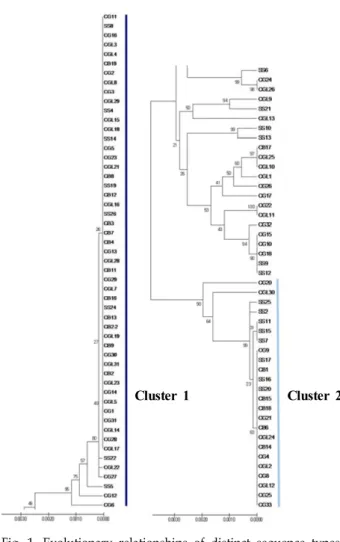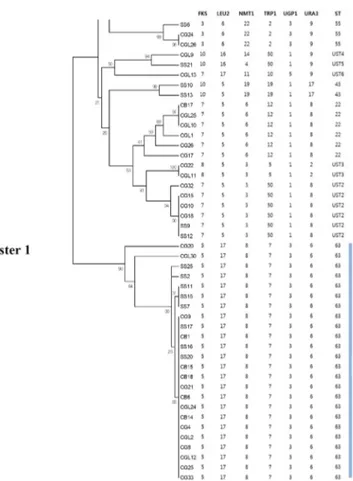Genetic Variations of Candida glabrata Clinical Isolates from Korea using Multi-locus Sequence Typing
Min Ji Kang
1, Kyung Eun Lee
2and Hyunwoo Jin
2*
1
Department of Microbiology, College of Medicine, Chungnam National University, Daejeon 34134, Korea
2
Department of Clinical Laboratory Science, College of Health Science, Catholic University of Pusan, Busan 46252, Korea Received October 23, 2019 /Revised January 17, 2020 /Accepted January 31, 2020
Although Candida albicans is the major fungal pathogen of candidemia, severe infections by non-albi- cans Candida (NAC) spp. have been increasing in recent years. Among NAC spp., C. glabrata has emerged as the second most common pathogen. However, few studies have been conducted to inves- tigate its structure, epidemiology, and basic biology. In the present study, multi-locus sequence typing (MLST) was performed with a total of 102 C. glabrata clinical isolates that were isolated from various types of clinical specimen. For MLST, six housekeeping genes—FKS, LEU2, NMT1, TRP1, UGP1, and URA3—were amplified and sequenced. The results were analyzed using the C. glabrata database. Out of a total of 3,345 base-pair DNA sequences, 49 variable nucleotide sites were found, and the results showed that 12 different sequence types (ST) were identified from the 102 clinical isolates. The data also demonstrated that the undetermined ST1 was the most predominant ST in Korea. Further, seven undetermined STs (UST) containing UST2-8 were classified at specific loci. The data from this study may provide a fundamental database for further studies on C. glabrata, including its epidemiology and evolution. The data may also contribute to the development of novel antifungal agents and diagnostic tests.
Key words : Candida glabrata, non-albicans Candida, candidiasis, genetic variations, multi-locus sequence typing
*Corresponding author
*Tel : +82-51-510-0567, Fax : +82-51-510-0568
*E-mail : jjjnhw@cup.ac.kr
This is an Open-Access article distributed under the terms of the Creative Commons Attribution Non-Commercial License (http://creativecommons.org/licenses/by-nc/3.0) which permits unrestricted non-commercial use, distribution, and reproduction in any medium, provided the original work is properly cited.
Journal of Life Science 2020 Vol. 30. No. 2. 122~128 DOI : https://doi.org/10.5352/JLS.2020.30.2.122
Introduction
Candida spp. belong to the normal flora of the vaginal tract, the gastrointestinal tract, and the oral cavity in human [8, 18]. However, rarely, serious infections, ranging from mucosal infections to systemic infection have been caused by Candida spp. [8, 18]. Fungal infections caused by Candida spp. have increased significantly, especially in acquired im- mune deficiency syndrome (AIDS) and immunocompro- mised individuals, including intensive care and, elderly pa- tients [3, 8]. Also, candidemia is associated with a high mor- tality rate approximately 30 to 40% in hospitalized patients and is difficult to treat, thus increasing the cost of medical care [3, 8].
C. glabrata has emerged as the second or third most com- mon Candida pathogen after C. albicans in the United States,
depending on the site [3, 7, 21]. Despite its increased preva- lence, there have been relatively few studies on the pop- ulation structure, epidemiology, and basic biology of C. glab- rata compared to those conducted on other Candida spp.
[6-8].
As mentioned above, C. albicans has considered to be the major fungal pathogen of candidemia in the past [6, 23].
However, as the number of severe infections caused by non-albicans Candida spp. (NAC) have increased, studies have shifted from C. albicans to NAC such as C. glabrata in recent years [11, 21]. Furthermore, since C. glabrata infections are often resistant to azole antifungal drugs, especially fluco- nazole, it is important to distinguish NAC from C. albicans to ensure the appropriate antifungal therapy and clinical management [8, 20, 21]. Thus, the discrimination of subtypes in these species are required for investigating their epidemi- ology and evolutionary biology [15, 23, 24].
In recent years, there has been substantial progress in the
development of several molecular methods for typing sub-
species and strains of fungi [26]. For instance, pulsed-field
gel electrophoresis (PFGE) compares total DNA band pat-
terns with or without restriction enzyme digestion, while
multilocus variable-number tandem-repeat (VNTR) analysis
Table 1. Details of diverse yeast isolates used in this study Clinical specimens No. of samples (%)
Blood Urine Bile Others
1)-
2)64 (63) 14 (14) 9 (9) 14 (14) 1 (1)
Total 102 (100)
1)
Others: ascitic fluid, joint fluid, pleural fluid, tissue etc.
2)



